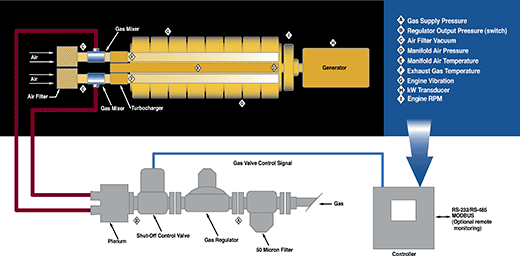Bi-Fuel Operation
& Installation

The GTI Bi-Fuel System provides gas to the engine using a technique known as fumigation. In a process similar to that utilized by carburetors found in spark engine applications, the system supplies gas to the engine using the original air intake system. In the typical configuration, the gas is introduced at a location upstream of the turbocharger and downstream of the engine air cleaner. The gas is introduced at approximately atmospheric pressure using a proprietary air-fuel mixing device that allows for a high level of fuel atomization with the smallest possible air restriction.
After exiting the mixer, the fuel-air charge is compressed in the turbo and then distributed to each cylinder by the engine air-intake manifold. The intake valves deliver the mixture to individual cylinders at the proper moment according to the normal valve timing of the engine. Upon entering the combustion chamber, the air-gas mix is compressed during the compression stroke and ignited when the diesel injector is activated.
Because a majority of the fuel and air is already pre-mixed prior to activation of the injector, the combustion differs slightly from the normal "stratified charge" process of the diesel engine. During bi-fuel operation, the combustion is slightly accelerated and the pressure rise in the cylinder is slightly "steeper" than normal diesel combustion.
Peak cylinder pressures reached during bi-fuel operation, however, are within normal limits. Although natural gas has a lower energy density than diesel fuel, the lean-burn/excess air operation of the diesel engine com-bined with the compression provided by the turbocharger, allow the system to supply adequate quantities of natural gas to the combustion chamber, therefore assuring that the equivalent power can be realized.
All OEM engine specifications for injection timing, valve timing, compression ratio, etc., remain unchanged after installation of the Bi-Fuel System, and no engine modifications are required.
The included control system monitors various engine parameters (depending on engine size and application) such as manifold air pressure (boost pressure), exhaust gas temperature, intake manifold air temperature, inlet air restriction, supply gas pressure and engine vibration. This data allows the system (see inset) to determine when to activate or deactivate bi-fuel operation depending on load level, ambient conditions, knock limits, low or high gas pressure or a detected malfunction in the engine. The automatic default mode is always to 100% diesel operation.
© Altronic, LLC


